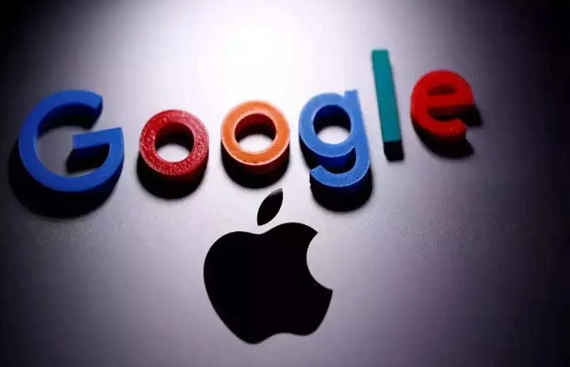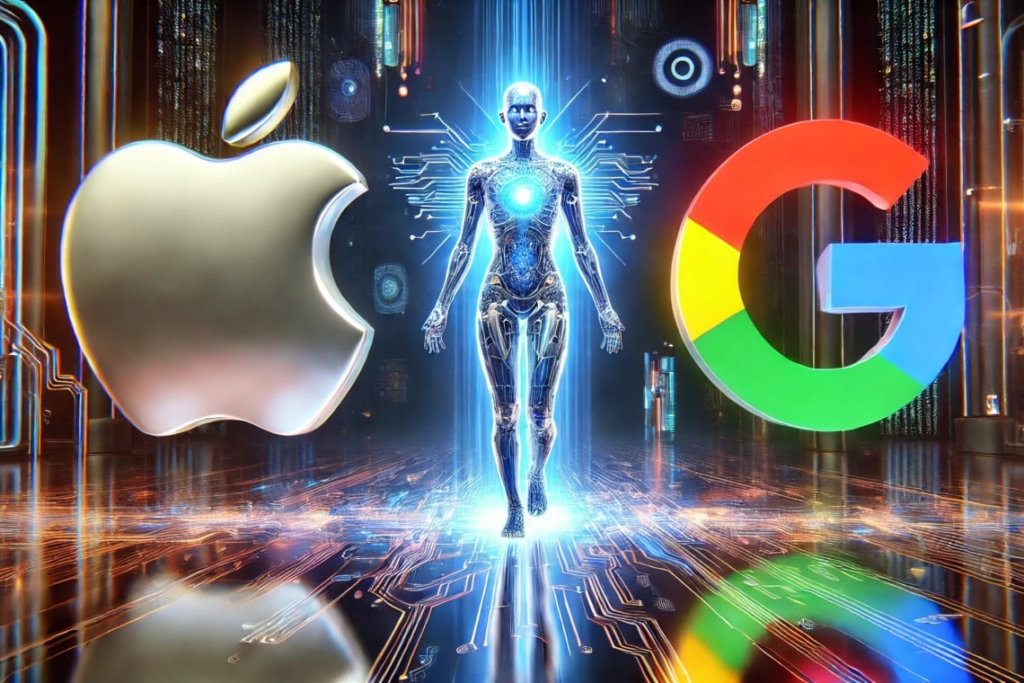In the rapidly evolving world of artificial intelligence (AI), Google has established itself as a titan, AI Dominance leveraging decades of research and innovation to build a formidable lead. Meanwhile, Apple, despite its massive user base and technological prowess, is still playing catch-up in developing key foundational AI technologies. This contrast highlights a critical moment in the tech industry, where Google’s long-term investments in AI infrastructure, data, and talent give it a significant advantage, while Apple works to bridge the gap with its privacy-focused approach and recent AI initiatives. This article explores how Google’s early bets on AI have positioned it as a leader and why Apple faces challenges in matching that dominance in the United States.

Google’s AI Journey: A Foundation Built Over Decades
Google’s AI journey began long before the current generative AI boom. As early as 2000, Google co-founder Larry Page envisioned a future where AI would power the ultimate search engine, capable of understanding user intent and delivering precise answers. This vision laid the groundwork for Google’s relentless pursuit of AI innovation. Over the years, the company has amassed a vast array of AI building blocks, from data collection to specialized hardware and groundbreaking algorithms.
One of Google’s key advantages is its unparalleled access to data. By indexing the web for decades and owning platforms like YouTube, Google has accumulated massive datasets to train its AI models. For example, its video-generation AI, Veo, relies on YouTube’s vast library to create professional-grade videos. Similarly, Google’s image-generation model, Imagen, and its large language model, Gemini, benefit from this data wealth. These models are built on the Transformer architecture, a research breakthrough pioneered by Google that underpins modern generative AI.
Google’s acquisition of DeepMind in 2014 further solidified its AI leadership. DeepMind, led by AI pioneers like Demis Hassabis, has driven innovations such as AlphaFold, which solved complex protein folding problems, and advanced reinforcement learning techniques. Additionally, Google’s development of Tensor Processing Units (TPUs) has given it a competitive edge in AI hardware, rivaling Nvidia’s GPUs. These TPUs, used in training Apple’s own AI models, demonstrate Google’s infrastructure dominance.
Google’s AI strategy extends beyond research to practical applications. Products like Google Search, Maps, Photos, and Workspace have been enhanced with AI for years, improving user experiences and driving productivity. For instance, the Search Generative Experience (SGE) uses large language models to deliver conversational search results, while Bard, Google’s AI chatbot, supports over 40 languages. These advancements reflect Google’s ability to integrate AI seamlessly into its ecosystem, making it a cornerstone of its product offerings.
Apple’s AI Ambitions: A Late Start with Promise
In contrast, Apple’s AI journey has been more restrained, shaped by its privacy-first philosophy and focus on user experience. While Apple has been embedding AI into its products for over a decade—think Siri and on-device machine learning for features like Face ID—the company has lagged in developing the foundational AI technologies needed to compete with Google’s generative AI capabilities.
At the 2024 Worldwide Developers Conference, Apple introduced Apple Intelligence, a personal intelligence system integrated into iOS 18, iPadOS 18, and macOS Sequoia. This system includes a 3-billion-parameter on-device language model and a larger server-based model running on Apple silicon servers. Apple has optimized these models for tasks like text refinement, notification prioritization, and in-app actions, emphasizing efficiency and privacy. However, Apple’s reliance on Google’s TPUs to train its foundational models underscores its lack of in-house AI infrastructure.

Apple’s strategy focuses on its ecosystem of over two billion iOS users, a strength that analysts see as a unique advantage. Rather than competing directly in cloud-based AI, Apple is betting on on-device AI processing and edge computing to deliver personalized, privacy-preserving experiences. For example, its MM1 family of AI models, developed by former Google researchers, uses text and visual inputs to enhance user interactions. Apple has also acquired over two dozen AI startups since 2015, integrating technologies into its devices, from the Vision Pro headset to music and health apps.
Despite these efforts, Apple faces significant hurdles. Unlike Google, Apple lacks the decades-long data accumulation and AI research infrastructure needed to build cutting-edge generative AI models. A recent report highlighted that Apple’s foundational AI technologies are still developing, requiring partnerships or further acquisitions to close the gap. For instance, rumors of a potential partnership with OpenAI, led by Sam Altman, suggest Apple may lean on external expertise to bolster its AI capabilities.
The Competitive Landscape: Google’s Lead vs. Apple’s Potential
The contrast between Google and Apple in the AI race is stark. Google’s early investments in AI research, data, and hardware have created a robust foundation that powers innovative products and services. Its open-source contributions, like TensorFlow, and developer tools, such as the PaLM API and MakerSuite, make AI accessible to enterprises and developers, further extending its influence. Google’s ability to pivot quickly in response to competitors like OpenAI’s ChatGPT—launching Bard and enhancing Workspace—demonstrates its agility and depth in AI.
Apple, however, is carving a different path. Its privacy-centric approach resonates with consumers wary of data collection, a concern less associated with Google’s data-driven model. Apple’s focus on integrating AI into its hardware ecosystem, such as the neural engine in M3 processors, positions it to monetize AI through services like an AI App Store, potentially generating billions in revenue. Analysts estimate Apple has already spent $10 billion on AI research in recent years, with plans to invest up to $5 billion annually to catch up.
Yet, Apple’s late entry into generative AI has sparked skepticism. Insiders warn that continued delays in mastering AI could threaten the iPhone’s dominance and Apple’s ambitions in futuristic products like robotics. Meanwhile, Google’s AI advancements are already reshaping industries, from healthcare (AlphaFold) to weather forecasting (GraphCast). The company’s ability to leverage its ecosystem and infrastructure gives it a head start, while Apple must rely on strategic hires, such as former Google AI experts, and acquisitions to build its AI arsenal.
What’s Next for AI in the U.S. Tech Landscape?
As AI becomes a defining technology, the U.S. tech industry is at a crossroads. Google’s decades of groundwork have positioned it as a leader, with a comprehensive AI ecosystem that spans research, hardware, and consumer applications. Its ability to harness vast datasets and cutting-edge hardware like TPUs ensures it remains at the forefront of AI innovation. However, Google faces challenges in maintaining its lead amid fierce competition and regulatory scrutiny, particularly as AI search threatens its core business.
Apple, meanwhile, is betting on its massive user base and privacy-focused strategy to carve out a niche in consumer AI. Its plans to revamp Safari with AI-powered search options signal a bold move to challenge Google’s dominance in search. Yet, Apple’s reliance on external infrastructure and its slower pace in building foundational AI technologies suggest it has a steep climb ahead. A potential leadership transition, with names like Sam Altman floated as successors to Tim Cook, could further shape Apple’s AI trajectory.

The AI race is not just about technology but also about vision and execution. Google’s long-term commitment to AI has given it a clear edge, but Apple’s ability to integrate AI into its ecosystem and prioritize user trust could make it a formidable contender. As both companies vie for dominance, the U.S. tech landscape will continue to evolve, driven by innovation, competition, and the quest to redefine how we interact with technology.
Google’s AI Dominance: Decades of Groundwork Give It an Edge Over Apple’s Emerging Efforts
Introduction
In the fast-changing world of artificial intelligence (AI), Google has built a strong lead through years of research and innovation. Meanwhile, Apple, despite its huge user base and tech expertise, is still working to catch up in key AI technologies. This article looks at how Google’s long-term AI investments give it an advantage and why Apple faces challenges in matching that strength in the United States.
Google’s AI Foundation
Google’s AI journey started over 20 years ago. In 2000, co-founder Larry Page dreamed of a search engine powered by AI that could understand exactly what users want. This vision drove Google to invest heavily in AI, building a strong foundation of data, hardware, and algorithms.
Data and Infrastructure
Google’s access to massive amounts of data is a key strength. By indexing the web and owning platforms like YouTube, Google has vast datasets to train its AI models. For example, its video-generation tool, Veo, uses YouTube videos to create professional content. Models like Imagen (for images) and Gemini (for language) also rely on this data. Google’s Transformer architecture, a major AI breakthrough, powers modern generative AI.
Acquisitions and Hardware
In 2014, Google bought DeepMind, a leading AI lab, which has created innovations like AlphaFold for solving scientific problems. Google also developed Tensor Processing Units (TPUs), specialized AI chips that compete with Nvidia’s GPUs. These TPUs are so advanced that even Apple used them to train its AI models.
AI in Products
Google has woven AI into its products for years, from Search and Maps to Photos and Workspace. Its Search Generative Experience (SGE) uses AI to make search more conversational, while Bard, its chatbot, works in over 40 languages. These tools show how Google uses AI to improve user experiences and stay ahead.
Apple’s AI Efforts
Apple has been quieter about AI, focusing on privacy and user experience. While it has used AI in products like Siri and Face ID for years, it lags in building the foundational technologies needed for advanced generative AI.
Apple Intelligence
At the 2024 Worldwide Developers Conference, Apple launched Apple Intelligence, a system built into iOS 18, iPadOS 18, and macOS Sequoia. It includes a 3-billion-parameter on-device model and a larger server-based model. These support tasks like text editing and notification sorting, with a focus on privacy and efficiency. However, Apple’s use of Google’s TPUs for training shows it lacks some key infrastructure.
Ecosystem Advantage
Apple’s strength is its ecosystem of over two billion iOS users. Instead of focusing on cloud AI, Apple prioritizes on-device AI and edge computing for private, personalized experiences. Its MM1 models, built by ex-Google researchers, combine text and visuals for better user interactions. Apple has also acquired over 20 AI startups to boost its capabilities.
Challenges
Apple faces hurdles in catching up. It lacks Google’s decades of data and AI research infrastructure. To compete, Apple may need partnerships, like a rumored deal with OpenAI, or more acquisitions to strengthen its AI foundation.
Comparing Google and Apple
Google’s early AI investments give it a clear lead. Its data, hardware, and tools like TensorFlow make AI accessible to developers and businesses. Apple, however, focuses on privacy and its ecosystem, aiming to monetize AI through services like an AI App Store. While Google’s AI is already transforming industries, Apple’s slower progress could impact its long-term competitiveness.
The Future of AI in the U.S.
Google’s strong AI foundation makes it a leader, but Apple’s user base and privacy focus give it potential. Apple’s plans to add AI search to Safari could challenge Google, but its reliance on external tech shows it has work to do. As AI shapes the future, both companies will drive innovation, with Google’s head start and Apple’s unique approach defining the U.S. tech landscape.
Sources
- Business Insider: Google Took 25 Years to Be Ready for Gen AI. Apple Is Just Starting.
- Apple Machine Learning Research: Introducing Apple’s On-Device and Server Foundation Models
- CNBC: How Apple’s thinking about AI spending and deployment differs from Big Tech rivals
Read More :- Security Startup Horizon3.ai Raises $100 Million to Bolster Automated Penetration-Testing Platform






